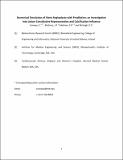| dc.contributor.author | McGarry, J. P. | |
| dc.contributor.author | McHugh, P. E. | |
| dc.contributor.author | Conway, Claire | |
| dc.contributor.author | Edelman, Elazer R | |
| dc.date.accessioned | 2017-08-23T19:01:18Z | |
| dc.date.available | 2018-03-04T06:00:06Z | |
| dc.date.issued | 2017-05 | |
| dc.date.submitted | 2016-12 | |
| dc.identifier.issn | 0090-6964 | |
| dc.identifier.issn | 1573-9686 | |
| dc.identifier.uri | http://hdl.handle.net/1721.1/111006 | |
| dc.description.abstract | It is acceptable clinical practice to predilate a severely occluded vessel to allow better positioning of endovascular stents, and while the impact of this intervention has been examined for aggregate response in animals there has been no means to examine whether there are specific vessels that might benefit. Finite element methods offer the singular ability to explore the mechanical response of arteries with specific pathologic alterations in mechanics to stenting and predilation. We examined varying representations of atherosclerotic tissue including homogeneous and heterogeneous dispersion of calcified particles, and elastic, pseudo-elastic, and elastic–plastic constitutive representations of bulk atherosclerotic tissue. The constitutive representations of the bulk atherosclerotic tissue were derived from experimental test data and highlight the importance of accounting for testing mode of loading. The impact of arterial predilation is presented and, in particular, its effect on intimal predicted damage, atherosclerotic tissue von Mises and maximum principal stresses, and luminal deformation was dependent on the type of constitutive representation of diseased tissue, particularly in the presence of calcifications. | en_US |
| dc.description.sponsorship | National Institutes of Health (U.S.) (R01 GM 49039) | en_US |
| dc.publisher | Springer-Verlag | en_US |
| dc.relation.isversionof | http://dx.doi.org/10.1007/s10439-017-1851-3 | en_US |
| dc.rights | Creative Commons Attribution-Noncommercial-Share Alike | en_US |
| dc.rights.uri | http://creativecommons.org/licenses/by-nc-sa/4.0/ | en_US |
| dc.source | Springer US | en_US |
| dc.title | Numerical Simulation of Stent Angioplasty with Predilation: An Investigation into Lesion Constitutive Representation and Calcification Influence | en_US |
| dc.type | Article | en_US |
| dc.identifier.citation | Conway, C. et al. “Numerical Simulation of Stent Angioplasty with Predilation: An Investigation into Lesion Constitutive Representation and Calcification Influence.” Annals of Biomedical Engineering 45, 9 (May 2017): 2244–2252 © 2017 Biomedical Engineering Society | en_US |
| dc.contributor.department | Massachusetts Institute of Technology. Institute for Medical Engineering & Science | en_US |
| dc.contributor.department | Harvard University--MIT Division of Health Sciences and Technology | en_US |
| dc.contributor.mitauthor | Conway, Claire | |
| dc.contributor.mitauthor | Edelman, Elazer R | |
| dc.relation.journal | Annals of Biomedical Engineering | en_US |
| dc.eprint.version | Author's final manuscript | en_US |
| dc.type.uri | http://purl.org/eprint/type/JournalArticle | en_US |
| eprint.status | http://purl.org/eprint/status/PeerReviewed | en_US |
| dc.date.updated | 2017-08-23T05:56:11Z | |
| dc.language.rfc3066 | en | |
| dc.rights.holder | Biomedical Engineering Society | |
| dspace.orderedauthors | Conway, C.; McGarry, J. P.; Edelman, E. R.; McHugh, P. E. | en_US |
| dspace.embargo.terms | N | en |
| dc.identifier.orcid | https://orcid.org/0000-0003-4236-2280 | |
| dc.identifier.orcid | https://orcid.org/0000-0002-7832-7156 | |
| mit.license | OPEN_ACCESS_POLICY | en_US |
| mit.metadata.status | Complete | |
